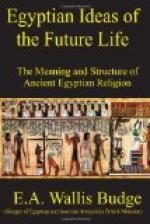There is every reason for believing that the prehistoric Egyptian expected to eat, and to drink, and to lead a life of pleasure in the region where he imagined his heaven to be, and there is little doubt that he thought the body in which he would live there would be not unlike the body which he had while he was upon earth. At this stage his ideas of the supernatural and of the future life would be like those of any man of the same race who stood on the same level in the scale of civilization, but in every way he was a great contrast to the Egyptian who lived, let us say, in the time of Mena, the first historical king of Egypt, the date of whom for convenience’ sake is placed at B.C. 4400. The interval between the time when the prehistoric Egyptians made the graves described above and the reign of Mena must have been very considerable, and we may justly believe it to represent some thousands of years; but whatever its length, we find that the time was not sufficient to wipe out the early views which had been handed on from generation to generation, or even to modify some of the beliefs which we now know to have existed in an almost unchanged state at the latest period of Egyptian history. In the texts which were edited by the priests of Heliopolis we find references to a state or condition of things, as far as social matters are concerned, which could only exist in a society of men who were half savages. And we see from later works, when extracts are made from the earlier texts which contain such references, that the passages in which objectionable allusions occur are either omitted altogether or modified. We know of a certainty that the educated men of the College of Heliopolis cannot have indulged in the excesses which the deceased kings for whom they prepared the funeral texts are assumed to enjoy, and the mention of the nameless abomination which the savage Egyptian inflicted upon his vanquished foe can only have been allowed to remain in them because of their own reverence for the written word.
In passing it must be mentioned that the religious ideas of the men who were buried without mutilation of limbs, or stripping of flesh from the body, or burning, must have been different from those of the men who practised such things on the dead. The former are buried in the ante-natal position of a child, and we may perhaps be justified in seeing in this custom the symbol of a hope that as the child is born from this position into the world, so might the deceased be born into the life in the world beyond the grave; and the presence of amulets, the object of which was to protect the body, seems to indicate that they expected the actual body to rise again. The latter, by the mutilation of the bodies and the burning of the dead, seem to show that they had no hope of living again in their natural bodies, and how far they had approached to the conception of the resurrection of a spiritual body we shall probably never know. When we arrive at the IVth dynasty we find that, so




